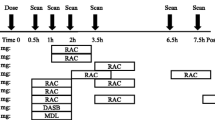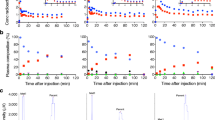Abstract
[carbonyl- 11C]WAY-100635 is a new radioligand which can be used with positron emission tomography (PET) to provide high contrast delineation of human brain regions that are rich in 5-HT1A receptors. In the present PET study, the binding of [carbonyl- 11C]WAY-100635 was characterized in the cynomolgus monkey brain. Pretreatment with each of the two reference compounds, WAY-100635 and 8-OH-DPAT, as well as the drugs buspirone and pindolol, induced a marked inhibition of [carbonyl-11C]WAY-100635 binding in the neocortex and the raphe nuclei. A preliminary Scatchard analysis yielded 5-HT1A receptor density values of the same order as those that have been reported in vitro. The study shows that [carbonyl- 11C]WAY-100635 binds specifically to 5-HT1A receptors in the primate brain and has potential for determination of 5-HT1A receptor occupancy and density in psychiatric patients.
Similar content being viewed by others
Author information
Authors and Affiliations
Additional information
Received: 24 December 1996/Final version: 7 March 1997
Rights and permissions
About this article
Cite this article
Farde, L., Ginovart, N., Ito, H. et al. PET-characterization of [carbonyl-11C]WAY-100635 binding to 5-HT1A receptors in the primate brain. Psychopharmacology 133, 196–202 (1997). https://doi.org/10.1007/s002130050391
Issue Date:
DOI: https://doi.org/10.1007/s002130050391




